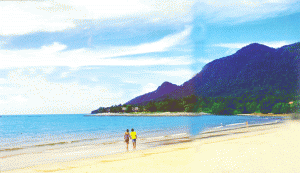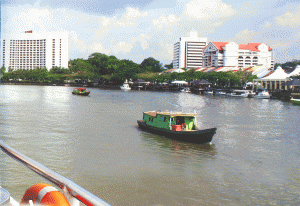When the average tourist or business traveler hears the name ‘Malaysia’, his or her mind rifles through images of Kuala Lumpur’s impressive skyline, or Penang’s white sandy beaches, or better yet, the crazy parties at Langkawi! For the more sedate, Malaysia may even spell the cultural richness of Melaka, and for the more audacious, perhaps the casinos at Genting. But this is only a small part of the Malaysia I have grown to love, having lived in the country for three years.
While cosmopolitan Malaysia does have its attractions from its amazing shopping to its awe inspiring development, it somehow falls short in fulfilling the soul’s inner desire to be one with nature. Don’t get me wrong, the better known West Malaysia is a phenomenally beautiful place with a plethora of sights and sounds that would leave anybody fascinated at the intricacies of the natural world. My point though is fairly simple; East Malaysia is at a far higher level of natural beauty altogether.
For those unfamiliar, East Malaysia – which comprises of two states, Sarawak and Sabah is a part of the world’s third biggest island, Borneo. Sharing borders on the island with Indonesia and the tiny – yet immensely rich – state of Brunei, East Malaysia lies across the South China Sea from Peninsular Malaysia (or West Malaysia).
After a two-hour flight from KL on board Asia’s largest no-frills airline, AirAsia, one of Malaysia’s greatest success stories, I was in Kuching, the capital of Sarawak. Kuching, which literally translates to ‘cat city’, ironically has nothing to do with the feline, as the city has been named after the Kuching River which in turn derives its name from a fruit – Mata Kuching or Cat’s Eyes – that is common at the river’s banks. Over time locals have taken a fancy to the literal translation of the city’s name such that today the cat has become the city’s symbol.

Kuching’s downtown is located along the banks of the Sarawak River and presents a serene atmosphere for both business and pleasure. While the cruise along the river is a must-do at sunset, the waterfront is home to the city’s Main Bazaar which is famous for its handicrafts. From traditional masks carved from monkeywood to vibrant batik shorts, the Main Bazaar will easily take up an entire afternoon.
Kuching is also home to the Semingoh Orangutan Rehabilitation Center which aims to rehabilitate confiscated orangutans that have been incapacitated or handicapped by prolonged captivity, with the eventual hope of releasing the apes into the wild. Ideally one should make it to the Center at feeding time as this allows ample opportunity to see these beautiful animals leisurely meandering through the trees.
Later, head off to Damai beach and check-in at the Damai Beach Resort. About 45 minutes from the city center, the resort is your ideal tropical getaway. With its hilltop swimming pool huddled in between palm trees overlooking the South China Sea, the hours will easily pass you by, while you waddle in the water or read a good book. If you’re not an avid swimmer, a ten-minute walk can take you to the Sarawak Cultural Village which is a living museum depicting the vibrant heritage of the various ethnic groups in the state. The village also serves as the setting for the World Rainforest Music Festival held in July every year, an event that attracts music lovers and artists from all corners of the globe. Do however make it a point to return to the main beach a half-hour before sundown as the sunset at Damai will leave you speechless, with the sun seemingly sinking in slow motion straight into the ocean!
One thought that strikes you wherever you go in Malaysia is the extreme social responsibility that in engrained in the society – in individuals and in organizations. Even commercial organizations like the Damai Beach Resort will exhibit a high level of CSR in the way they work to preserve the environment, reduce their use of non-renewable natural resources and create the highest standards of service possible. All this of course pays back into their business, as CSR should, and they benefit from building customer loyalty and creating a sustainable business overall.
After enough sun, sand and culture in Damai, you are ready to leave the city. But before you go, do drop in at the Cat Museum. In addition to the city’s history, the museum traces the impact of felines on human history from the use of the word cat in the English language (think ‘catnap’, ‘catwalk’, etc) and the role of cats in various civilizations to the impact of felines on today’s pop culture.
An hour’s flight from Kuching, is the capital of Sabah. Kota Kinabalu, or KK as it is popularly known, is a growing resort destination which acts as a gateway to tropical islands, lush rainforest, and Mount Kinabalu. Just off the coast of the city is the Tunku Abdul Rahman Marine Park which comprises five islands offering numerous scuba diving and snorkeling opportunities.
If marine life is not your cup of tea, then head off to the Taman Negara Kinabalu (or Kinabalu National Park). Malaysia’s first World Heritage Site designated by UNESCO, this park covers an area of 754 square kilometers around Mt. Kinabalu which stands at a towering 4,095 meters. While climbing the mountain is quite a popular attraction with tourists, be warned that you need to be very physically fit to accomplish the seven-odd hour trek to the top. If you do muster the guts to take on the mountain and reach the top where you spend the night, your reward will be a tranquil sunrise when you wake up the next morning, as well as a certificate on your return to the bottom.
Kinabalu National Park is also home to a wide variety of flora and wildlife. In fact, the park is one of the only places in the world where one can cite the world’s largest flower. The Raffelsia only blooms for a maximum of five days in a year and boasts a diameter that can extend to almost a meter and a weight that can be as heavy as 10 kilograms.

When leaving the park you can either go back to the city center and treat yourself to some incredible seafood at KK’s extended waterfront area, or if you are in a more intrepid mood, you could hop on a three-hour bus ride to the Sepilok Rehabilitation Center, which is the world’s largest orangutan sanctuary – offering visitors the chance to spend a few nights in thick rainforest and experience firsthand how life in the jungle feels.
As I left Borneo and made my way back to KL, I couldn’t help but mull over the fact that a lot of upper – and even the middle – class tourists have learnt to distinguish between an Armani and a Versace, and might sip the fanciest cappuccino in a downtown bistro, but their aesthetics have not evolved to include the appreciation of nature.
I, for one, feel that a shopping mall is a shopping mall regardless of where you go. On the contrary, the natural world is so diverse and vibrant that even a move from one state such as Sabah to another state such as Sarawak, will allow you a completely different experience. My advice therefore to people traveling to Malaysia is that while focusing on Peninsular Malaysia, do take time out to head east, on the road less traveled and discover a spiritually uplifting natural world that will truly make your visit complete.






done! come back and be my tour guide! =D
u make me feel so proud to be a malaysian =P
tc jafer! =)
@ BABAR JAVED: Given that Malaysia is comprised of three distinct races coupled with the fact that there is never a shortage of tourists in the country, assimilating into Malaysian society was quite easy for me. In fact, my three years there gave me ample opportunity to interact with people from all walks of like. In my experience, locals everywhere were extremely cordial, although their initial shyness could be mistaken for anti-social behavior.
Moving on, for me as a Pakistani, the change in lifestyle brought about by a shift to Malaysia was relatively small when compared to a similar shift to the West. This because Malaysia too has strong Islamic values rooted among its majority Muslim population (values which by traditional Pakistani standards would be considered quite liberal). Lastly, living standards in Malaysia are so high and life is so trouble-free that as a Pakistani you can’t help but wonder why we cannot learn from the Malaysian miracle and harness our own diversity to spearhead growth.
All in all, Malaysia is ‘truly Asia’!
@ HUSSEINA: I sincerely hope this article spurs you to go to Borneo. Or better yet, wait a while and I’ll come there and serve the purpose of your tour guide :)
I’m Malaysian and I’ve not traveled to the Borneo Island =( I will someday =)
Btw, come back for a visit, would love to see you again!
3 years is more than enough time to gauge an impression of the people, culture and standards I’d say. So how was your time as a student at Nottingham Malaysia and in that the ease/difficulty of integrating with the society given your Pakistani base?